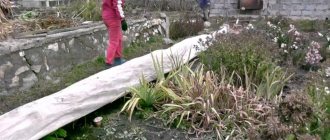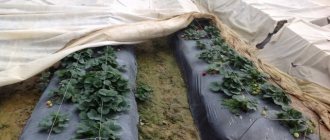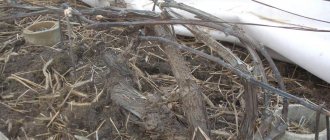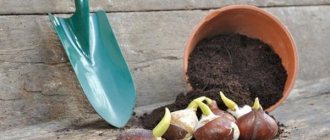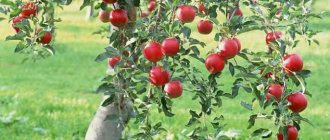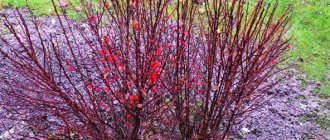Preparing grapes for insulation
Since in recent years, instead of severe frosts, long-term thaws have been observed more often, it is necessary to first prepare the grapes for insulation, and then cover them. Preparation includes several mandatory steps.
- Remove the vine from the trellis.
- Trim.
- Remove trimmings and excess vegetation from the main bush.
- Treat the bushes with special products to protect them from diseases and pests - vitriol, nitrafen, Dnok preparations and others are suitable.
- Water the grapes generously before cold weather.
- Fertilize the soil so that the roots have additional nutrition.
- If necessary, set rodent traps to protect roots.
If possible, leave the vine uncovered for about a month after natural leaf fall and the first frost. During this time, there will be an outflow of nutrients to the root system, which will help it to be better preserved.
During watering, it is necessary to moisten the soil to a depth of 1-1.5 meters. With the help of “moisture-recharging” irrigation, you will be able to preserve the plant’s root system and nutrients for it.
Suitable fertilizers include:
- superphosphates;
- wood ash;
- complex fertilizers that do not contain nitrogen.
Thanks to the nutrients they contain, the risk of infection of the grape root system with fungal infections will be reduced.
Preliminary preparation for cold weather
Pruning grapes in autumn
Depending on the variety and age, grapes can withstand temperatures from -13°C to -28°C. The root system of bushes is less resistant to frost and can withstand from -9°C to -14°C. The older the plant, the more frost it can withstand. In cold regions where temperatures drop below -21°C, it is recommended to cover all grape varieties. Frost-resistant varieties do not need to be covered down to -20°C.
Pruning and treating grapes from pests in the fall is a mandatory method of preparing for winter before sheltering. Without it, it is difficult to ensure healthy plants and high productivity.
Vine pruning
Grapes are pruned no earlier than October, after the harvest has been harvested and all the foliage has fallen. At this time, the movement of sap in the stems stops and pruning can be done without harm to the plant. During pruning, cuttings can be prepared for subsequent propagation of grape bushes.
It is necessary to leave shoots in accordance with the chosen shape of the bush, which will bear fruit in the next season and remove all unnecessary: damaged, diseased, broken, dry or old vines. In cold climates, pruning can be done a third less than in warm regions. This way you will leave a reserve that can be removed in the spring if necessary.
Autumn processing
After the harvest has been harvested, the leaves have fallen and the bushes have been pruned, they must be treated to protect them from pests and various diseases. At this time, you can use any chemicals, such as:
- Inkstone.
- Copper sulfate.
- Bordeaux mixture.
- Slaked lime.
Important! Iron sulfate reduces the frost resistance of grapes, so many winegrowers recommend replacing it with other substances.
Processing grapes in the fall before covering is an important stage of plant care that should not be skipped if you want to harvest next year.
Hilling up with earth
One of the simplest and most affordable methods of insulation. How to implement it:
- prepare turf or soil, first placing it in bags;
- some time after the onset of light frosts, remove the vine from the trellis and lay it on the ground or in a shallow groove;
- cover the grapes with a layer of earth about 10 cm high and leave for a month;
- add more soil or turf to increase the cover layer to 20 cm in height.
Preliminary preparation of soil or turf will help avoid problems with digging up frozen soil to increase the layer of the embankment.
Pros and cons of the method:
- you can quickly cover the grapes;
- practically no financial investments are needed;
- you can always take land from the site;
- When stored in bags, the soil or turf will dry out and provide better protection for the grapes from cold and humidity.
- during severe winters, the cold can “reach” the grapes even through a layer of soil;
- not everyone has space to store bags of soil or turf;
- During the thaw, water will begin to erode the soil and create excess dirt.
Sheltering grapes in autumn is important
The root system of grapes is most vulnerable, so it requires warmer and more serious shelter. When the soil freezes to -5°C, the roots are on the verge of freezing. This means that the entire bush is under threat. If, when the ground part of the bush is frostbitten, complete restoration of the plant is still possible, then when the roots freeze, the vine dies completely.
Therefore, it is necessary to cover the grapes in winter and provide them with reliable protection. At the same time, the method of shelter and its necessity depends on the region where the grapes are grown.
Snow shelter
Simple insulation of grapes, applicable when the following conditions are met:
- In winter there is always a large amount of snow;
- A midwinter thaw is an extremely rare occurrence in the region.
To cover the grapes you will need:
- place boards or plywood on the ground;
- lay the vine on the resulting flooring;
- secure the grapes with metal staples or wire;
- cover the vine with a layer of snow at least 50 cm high.
Expert opinion
Dmitry Valentinovich Reznikov
Lisichansk, Lugansk region, experienced winegrower
In winter, you need to periodically add and compact snow, since part of the bulk shelter can be blown away by the wind.
Pros and cons of the method:
- can be used when the timing of shelter has been missed and snow has already fallen;
- the shelter does not require financial investments if the farm has old boards or plywood;
- you can quickly insulate grapes;
- does not require much effort for insulation;
- the natural insulation does not need to be removed, since it will melt on its own with the onset of spring.
- there is a risk that frosts will strike at the beginning of winter, and there will be no snow, or there will be too little snow;
- in the event of a series of frosts and thaws, the grapes may freeze and die;
- the shelter is unstable; in the event of a thaw, the depth of the snow cover will decrease.
Timing for covering bushes
There is no clear date for this procedure. Gardeners recommend starting work in October, when the harvest has already been fully harvested. At this time, you can prepare for wintering and create protective structures for the vines.
In addition, the timing largely depends on the grape variety. It is necessary to take into account their degree of tolerance to temperature drops below 0°C. Experienced winegrowers do not recommend covering bushes with the onset of the first frost. It is recommended to wait until the end of October - beginning of November, when the air temperature drops to -5°C. This will give the culture an opportunity to harden, which will have a beneficial effect on its development in the future.
A strong, well-groomed vine can cope with cold weather without any damage. In any case, even if the autumn turned out to be warm, protective structures are being prepared by the end of October. In the event of a sudden hard frost, the grapes will be protected.
Before covering the bushes, they must be trimmed. At this time, it is imperative to monitor the temperature, which can drop sharply. If it falls below -12 °C, the grapes may die.
The culture has this peculiarity: the more it bears fruit, the more vulnerable it becomes to frost. Also, the frost resistance of a bush depends on its age. The older it is, the stronger and more seasoned it is. Young grapes, which do not yet have a thick bark, require careful attention.
Insulation with straw
An environmentally friendly and fairly cheap way to cover grapes. This is done as follows:
- lay boards or plywood on the ground;
- put the vine on the flooring;
- pour a 20 cm high layer of straw on top, alternative materials are reed or cattail;
- after 20 days, add another 20 cm of plant mass;
- secure the shelter with metal brackets, cover with film or agrofibre for additional thermal insulation.
Pros and cons of the method:
- straw and reeds provide good ventilation;
- natural materials are used for insulation;
- relatively cheap shelter;
- Collected fallen leaves can be used as a substitute for straw or reeds.
- plant materials must be dried in advance;
- there is a risk of rodents, you will need to use poison;
- the vegetable covering layer is difficult to remove.
Covering it correctly
First, it is important to prepare the bushes: as necessary, they are watered, fed, pruned and treated with pests and infections.
Can:
- spud;
- partially cover;
- cover completely.
For first-years, hilling is often used as a wintering shelter. This is enough for young grapes. For hilling, it is recommended to create a dense mound of soil with a height of at least 10 cm, but no more than 25-30 cm.
Insulation with sawdust
In this case, you will need to additionally isolate the material from moisture. How to properly create such a shelter:
- cover the soil around the grape bush with film;
- lay the vine on the film;
- cover the grapes with a layer of sawdust;
- cover the sawdust with a board or slate to protect it from moisture from above.
Pros and cons of the method:
- low material costs;
- environmental friendliness;
- sufficient ventilation is ensured.
- The sawdust itself needs protection from moisture, and is difficult to remove in the spring.
Nuances of the process depending on the age of the bush
The choice of covering method is also influenced by the age of the grape bush. The younger the vine, the less resistant to low temperatures and the more it needs winter insulation.
Immediately after planting in the fall
To protect a young seedling from the cold, it is insulated with fabric, straw or waterproof material, and a layer of earth is added on top. For these purposes, they often use a plastic bottle or an old bucket and also sprinkle it with earth.
Annual
For annual grapes, the most suitable method is hilling. Depending on the frost resistance of the variety, the bushes are covered with a layer of earth from 15 to 25 cm. In cold regions, they are also additionally covered with a film, which is secured on the sides with metal pins or earth.
Two year old
Autumn pruning of two-year-old grapes is an important stage in the formation of the crown. By this time, the bush already has 4-6 vines. In autumn they are pruned, leaving 2-3 buds on each. This will make it easier to cover grapes that have not yet matured. Two-year-old grapes are also covered with soil and additional insulation with film.
Three year old
To cover a three-year-old bush, the branches are tied together in bunches and stapled to the ground. Next, insulate it in any convenient way.
Spunbond shelter
Using this lightweight material, also known as agrofibre, fiberglass or agrotextile, you can cover grapes in several ways.
- Frame insulation. Leave the grapes on the trellises and cover them with one or several layers of spunbond. If there is a lot of snow in winter, one layer is enough. In case of snowless and cold winters, several layers will be required to better retain heat.
- Dry cover. In this case, you need to remove the grapevine from the trellis, wrap it in several layers of spunbond and lay it on the ground, fixing it with staples.
Spunbond should always be firmly fixed to the ground or trellises. The material is very light and can fly off when exposed to wind.
Pros and cons of the method:
- agrofibre provides good ventilation while minimizing heat loss;
- spunbond is a natural eco-friendly material;
- It's easy to make a shelter for grapes.
- material cost;
- According to the experience of gardeners, in harsh winter conditions agrofibre alone may not be enough.
It is best to use white spunbond. Black material is intended for mulching the soil and does not have the characteristics necessary for high-quality cover of grapes.
Covering grapes for the winter with synthetic non-woven materials
Today, the industry produces many different materials for the market, some of which can be perfectly adapted to cover grapevines for the winter. It can be spunbond, padding polyester, batting and others.
synthetic batting for many years . This material is produced from light industrial waste and has many advantages:
- Easy to cover and reveal bushes
- Easy to store - the most important indicator, at least in our small area
- Durability - rot resistant, does not decompose in the sun
- Air permeability - the vines winter well, do not freeze, do not rot, and are not damaged by mice
- Excellent snow retention - additional thermal insulation
As you can see in the photo, the mats are simply thrown over the bottom wire and pinned to the ground.
This material has proven itself well on our site, simplicity and ease of work are its main advantage, the vines under it have never withered or frozen, mice also do not like it. The compactness of the material makes it easy to store; this, by the way, is a very important point; in a sick vineyard, the problem of storage is very pressing. The durability of the material allows it to be used indefinitely; synthetics do not rot or decompose in the sun, which is also very important. The material holds the snow cover well and at the same time does not allow moisture to pass inside, melt and rainwater flows from it like from a thatched roof, and it is always dry inside.
The only disadvantage is the price, but for us the simplicity and ease of operation pays off these costs a hundredfold; taking into account the durability, the cost is no longer so scary.
You can cover it with film in the same tunnel method, you just need to provide ventilation.
Shelter made of spruce branches
One of the best ways to insulate grapes for the winter. Especially if there is a coniferous forest near the site.
How to make a shelter correctly:
- lay the vine on the ground;
- cover the grapes with a layer of spruce branches about 40 cm high.
Expert opinion
Dmitry Valentinovich Reznikov
Lisichansk, Lugansk region, experienced winegrower
Some gardeners make a box of slate or boards around the bush to save space. Thanks to this, less spruce branches are required.
Pros and cons of the method:
- fast;
- cheap or completely free;
- needles also work as protection against rodents;
- under the layer of spruce branches, the grapes do not rot and are not exposed to fungi and mold.
- optimal only if there is a coniferous forest nearby.
Types and methods of shelter
Each region and grape variety has its own shelter characteristics. You can cover the vine in a timely and correct manner by gaining experience working with this crop. How to insulate fruit-bearing grapes for the winter? There are several common methods.
Hilling
Young seedlings or adult bushes in the southern regions, as well as frost-resistant grape varieties, can be insulated by hilling up the earth at a height of 10-25 cm. The head of the bush should be completely covered with earth. The diameter of the mound is about 30 cm.
After this, the vine is removed from the trellis and laid on the bottom wire or simply on the ground, laying boards. At winter temperatures no higher than -15° C, no other shelters are required.
This shelter is suitable for areas where snow falls early and heavily. Having covered the grapes lying on the ground with snow, you don’t have to worry about their wintering.
Incomplete cover
It is used in the Black Earth region and in the north of the southern regions. The bush is covered not completely, but partially; we are talking about non-winter-hardy parts: the head, the lower sleeve, the bases of the shoots.
The base is covered with earth, and the top of the bush is wrapped in spunbond, burlap, and an old blanket.
Fir branches
The harvested grapes are tied, bent, twisted into a ring, fixed and covered with spruce branches. The colder the weather, the thicker the layer of branches required. The shelter is very reliable, but due to the difficulty of finding spruce branches in the required quantity every year, it is usually used only for sheltering seedlings.
Dry shelter is the most reliable and fastest way to protect against frost. It consists of the construction of two rows: thermal insulation and moisture proof.
For thermal insulation, use sawdust, pine litter, straw, shavings, spruce branches, and a 3 mm thick laminate backing (which serves as waterproofing).
The moisture-proof coating is usually an opaque film, but you can use roofing felt, slate, linoleum, or fiberglass.
In the trenches
Complete cover of the bush is necessary when frosts of -20° C arrive. When planting a row of grapes on the site, prepare a ditch 20-30 cm deep and 50 cm wide in advance, strengthening the walls with boards and spacers.
Grapes grow from a trench in which they are placed when cold weather sets in. Cover the vine with a layer of insulation. The top is covered with wooden flooring and covered with roofing felt or film.
Under the slate
The covering material for the grapes in this case is slate sheets mounted on a frame made of wooden blocks. The grapes are finally covered when cold weather sets in, covering the structure with film or plant mats from the ends of the building.
Air-dry shelter
The vines tied and laid on the ground are covered with a dry leaf or spruce branches, a film rolled in several layers is placed on top of a frame of arches and pressed to the ground with bricks.
Important! Sheltering one-year-old seedlings can be done using 5-liter water bottles.
Their bottom is cut off, placed above the sprout and the base is buried in the ground.
The gardener decides how to cover non-winter-hardy grapes independently, based on the climate of the region and his site, and the winter hardiness of the planted varieties.
Warming fruit-bearing grapes for the winter is one of the most important operations in growing crops. How to close grapes for the winter, which method to choose - must be determined based on the capabilities and available materials.
Don't forget a few mandatory rules:
- between the grapes and the ground there should be only bedding material without insulation or insulation. The earth is a source of heat for the plant in winter;
- You cannot hermetically cover the vine without leaving holes for air circulation. Otherwise, the grapes will be left to rot in the thaw;
- a mistake in choosing a covering method that is not suitable for a particular area can destroy the entire plant.
Trench method
An equally popular method that allows you to reliably protect the vine from freezing and death. To cover grapes using this method, you will need:
- dig grooves 0.5-0.7 meters deep;
- place boards or slate on the bottom of the grooves;
- lay the grapevine on top of the flooring;
- cover the grapes on top with straw, peat or sawdust;
- cover the entire structure on top with spunbond.
Pros and cons of the method:
- a layer of wood or slate will protect the vine from rotting;
- sawdust and straw will additionally retain heat;
- snow collects on the spunbond and creates an additional protective layer.
- additional effort and time will be required to dig grooves;
- The spunbond will have to be changed almost every year.
Formwork can be installed on the sides of the trench. This will reduce the risk of soil erosion and damage to the vines during a thaw.
Shelter made of solid materials
Another variation of trench insulation. In this case, you can use boards, or the remains of roofing felt or slate. The principle of creating a shelter:
- dig trenches 0.2-0.3 m deep;
- wrap the vine with burlap;
- lay the branches in the grooves, securing them with metal staples;
- cover the trench with hard covering material;
- cover the structure with soil from above.
Pros and cons of the method:
- reliability;
- wind resistance;
- retains heat well;
- solid building material can be used for several years.
- this method is justified only when roofing felt, slate or boards are left after repair or construction, since targeted purchase of materials will be expensive;
- Due to the shape of the sheets, slate can break under the weight of snow and damage the vine.
When covering, sheets of solid material should extend beyond the edges of the trench by 10-15 centimeters. This will provide better protection from precipitation and reduce heat loss.
Which grapes can not be covered for the winter?
Typically, technical grape varieties do not require insulation and winter well without special shelter. The buds are not damaged and the vine is preserved when the temperature drops to - 20°C for Isabella, Lydia, Concord, Race, etc. Industrial grapes are less sensitive to frost and have increased immunity compared to dessert hybrids.
Frost-resistant hybrids Vostorg, Krasa Severa, Nadezhda Azos, Dekabrsky, Kasparovsky. And the Muscat dessert are stored until spring without the use of insulation. But this wintering option is suitable for warm climates. In regions with frosty winters, dessert grapes will produce a harvest if all the buds and shoots are preserved. To do this, it is recommended to carefully cover young shoots and woody vines. In this case, be sure to provide air flow for ventilation.
Covering with film
A simple method of insulation, applicable in regions with relatively warm winters. What do we have to do:
- install wire arcs over the grape bushes - just stick them into the ground, no need to fasten them;
- lay the film on the wire;
- Press the edges of the film, sprinkle it with earth, but leave a gap for air on one side.
When cold weather sets in, the air gap must be closed so that the bushes do not freeze.
Pros and cons of the method:
- simplicity;
- cheapness;
- availability of materials.
- there is a risk of a greenhouse effect occurring during a thaw, which can cause the bush to rot;
- if the film fits tightly to the bush, branches can damage it, and frosty air can get inside through the holes.
Instead of film, use fiberglass (spunbond). It allows air to pass through well, provides ventilation and does not create a greenhouse effect. Plus, fiberglass is denser than film and provides more reliable protection from the cold.
Covering with earth
The practice of burying grapes in soil came to us from the south, where there is no stable snow cover. It has its advantages - covering material is always at hand, but also a number of disadvantages - first of all, it is very labor-intensive, this is the first and second - bushes buried in the ground with frequent thaws in autumn and winter get very wet, and as a result, they get wet, the eyes rot and die. In some years the attacks can be very significant.
Before burying, it’s a good idea to place cut polypropylene fertilizer bags on the vines; this will greatly facilitate the work when digging up the vines, and will also preserve the aesthetic appearance.
